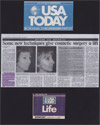Some New Techniques Give Cosmetic Surgery A Lift
USA Today – February 1989
Surgeons across the USA are changing the face of plastic surgery with new and revised procedures. Cosmetic surgery jumped 24 percent between 1984 and 1986, according to a survey from the American Society of Plastic and Reconstructive Surgeons. Some of the latest operations and techniques include submalar augmentation, a procedure which involves inserting solid silicone implants below the cheekbones through an incision inside the mouth.
Developed by Dr. William Binder, a clinical faculty member of surgery at UCLA, submalar augmentation is especially attractive to people between 38 and 50 – when the fatty tissues around the cheeks begin to atrophy, giving the face a hollow look. Binder, who has studied 170 patients for an aaverage of 3 1/2 years, says the the procedure “postpones the face lift procedure for when it will do the patient the most good.”
Several surgeons who use BInder’s implants call it a missing link in facial plastic surgery, while others caution that augmentation below the cheekbones would only benefit a small group of people who are thin to begin with, and others who will still benefit from a face lift. Binder counters: “Most of the aging phenomenon occurs in the mid-third of the face and therefore that is the area that needs to be augmented and treated.” Histoacryl, a type of “Super Glue” used to close some lower eyelid surgeries, is manufactured in West Germany and can be used to close some wounds that are not under tension, eliminating suture marks. One operation for correcting crow’s feet in older patients involves a “tuck” in skin at the corner of the eye, leaving a small scar shaped like an “X”. Other procedures to correct crow’s feet involve fixing the squinting muscle, or simply removing skin to give a dramatic enough improvement. Facial plastic surgery should not be taken lightly simply because its purpose is to improve appearance. Like any other surgery, it carries risks and involves some personal considerations.

